Jane Lindskold's Blog, page 38
January 7, 2022
FF: Re-Reading SK4
 Roary Dreams of Treecats
Roary Dreams of TreecatsMom left the 27th. By the 28th, I was immersed in re-reading the fourth of the Star Kingdom books, written by me in collaboration with David Weber. He’d just addressed the editor’s notes, and my job was to see how smoothly it went. Since I hadn’t read the book since late 2020, I had a good, fresh point of view.
Oh, when will it be out? June 2022, now titled A New Clan.
For those of you unfamiliar with this column, the Friday Fragments lists what I’ve read over the past week. Most of the time I don’t include details of either short fiction (unless part of a book-length collection) or magazines. The Fragments are not meant to be a recommendation list. If you’re interested in a not-at-all-inclusive recommendation list, you can look on my website under Neat Stuff.
Once again, this is not a book review column. It’s just a list with, maybe, a bit of description or a few opinions tossed in. And it’s also a great place to tell me what you’re reading. Two of the series I’m trying right now are due to FF reader mentions.
Completed:
Whispers Underground by Ben Aaronovitch. Audiobook. Book three in the series. Much enjoyed.
In Progress:
The Liar’s Knot by M.A. Carrick. Sequel to The Mask of Mirrors. Almost done. I’m enjoying very much. The “knot” in the title has at least a double meaning, probably triple. I approve.
Foxglove Summer by Ben Aaronovitch. Audiobook. Book five in the series. I skipped right into a major spoiler, but Aaronovitch is a skilled enough writer that I now want to read book four, as well as one and two. This is not always the case for me, so praise is due.
Also:
Archeology Magazine with the summary of 2021 discoveries.
January 5, 2022
The Box Arrived!
 Library of the Sapphire Wind is Here!
Library of the Sapphire Wind is Here!My author’s copies of Library of the Sapphire Wind were dropped off as 2021 was on its way out, a very nice way to end the old year and start anticipating the new.
So, what is Library of the Sapphire Wind about? Here’s a behind-the-scenes look at an early version of the cover copy. I am choosing the one below because you can read the other elsewhere, and this is somewhat longer. I’m also choosing this because a few early reviewers have expressed disappointment when they realized the book isn’t set at the Library.
Instead of Mentors, They Got Monsters…
That’s what Xerak, Vereez, and Grunwold think when three strange creatures shimmer into being within the circle of Hettua Shrine. Their conclusion is reasonable enough. After all, they’ve never seen humans before.
As for Margaret Blake, Peg Gallegos, and Tessa Brown—more usually known as Meg, Peg, and Teg—they’re equally astonished but, oddly enough, better prepared. Age and experience have accustomed them to surprises. A widely varied course of reading material has intellectually prepared them for the idea that other worlds, even worlds where people with traits more commonly ascribed to “animals,” may exist.
Then there is the mysterious verse that Teg speaks as they arrive, words that seem to indicate that the Shrine must have been at least partially responding to the request made of it.
Despite doubts on all sides, the three unlikely mentors join forces with the three young “inquisitors” and venture out into the world Peg dubs “Over Where.” First, they must find the Library of the Sapphire Wind, destroyed years before.
Will they find answers there or is this only the first stage in their search?
I hope you’ll try the novel of which Publisher’s Weekly has said: “This vivid, magical tale is sure to please.”
And I’d be very happy to answer any questions, especially if I can do so without providing spoilers.
It turns out that 2022 will be unique for me as a writer in that I’ll have three books coming out in something like six months: Library of the Sapphire Wind on February 1; the sequel, Aurora Borealis Bridge on April 1; and A New Clan, the long-awaited new Star Kingdom/Stephanie Harrington novel in June.
With that, I need to get back to work!
December 31, 2021
FF: Slowing Down
 Jingles in the Magical Forrest
Jingles in the Magical ForrestHappy New Year’s Eve, folks…
This past week, holiday cooking and house guests seriously cut into my reading time.
So has spending my work time proofreading, which I started almost as soon as I got home from putting my mom on her plane. Therefore, I don’t think I have anything new to offer this week. Therefore, we offer you a picture of one of our Christmas decorations: the Breyer pony “Jingles” and his sleigh load of misfit toys.
For those of you unfamiliar with this column, the Friday Fragments lists what I’ve read over the past week. Most of the time I don’t include details of either short fiction (unless part of a book-length collection) or magazines. The Fragments are not meant to be a recommendation list. If you’re interested in a not-at-all-inclusive recommendation list, you can look on my website under Neat Stuff.
Once again, this is not a book review column. It’s just a list with, maybe, a bit of description or a few opinions tossed in. And it’s also a great place to tell me what you’re reading. Two of the series I’m trying right now are due to FF reader mentions.
Completed:
Written in Stone by Christopher Stevens. Non-fiction on Indo-European root words. Interesting, but not very scholarly, almost more like stream of consciousness association. I’d love a recommendation of a book that was similar to P.E. Cleator’s Lost Languages, in that it would be partially about the deciphering process, partially about the people who took on the challenge.
In Progress:
The Liar’s Knot by M.A. Carrick. Sequel to The Mask of Mirrors. Very good so far.
Whispers Underground by Ben Aaronovitch. Audiobook. Great fun so far.
Also:
Finished the most recent Smithsonian and almost all of the most recent Vogue. Human culture is certainly varied and complex.
December 29, 2021
Shy Mei-Ling and the Invader
 Who’s Coming Down the Hallway?
Who’s Coming Down the Hallway?My mom came for Christmas, our first overnight house guest since 2018. Mei-Ling came to live with us in August of 2019, as a very shy fourteen-week-old kitten. She had just begun to entertain the idea that people other than me and Jim in the house might be a good idea when the pandemic shutdown hit and she had the luxury of over a year to renew her opinion that visitors were not to be befriended, but to be waited out.
This was her tactic when Mom arrived on the 22nd. Mei-Ling dove into the closet in our bedroom and refused to emerge, even for dinner. When Mom settled down in the guest room, behind a closed door, Mei-Ling emerged, which is probably a good thing, since the litter box is not in our bedroom closet.
Roary, who also had never dealt with an overnight guest, was also uncertain. At first, he hid in the closet with Mei-Ling, but by later on the 23rd, Roary (probably taking his cue from Persephone, for whom Mom is a longtime friend), began to join the party from a discreet distance. By the morning of Christmas Eve, he even let Mom take his picture.
Maybe this is why, by mid-day on the 24th, Mei-Ling was at least up on our bed, and then, by evening, when we settled down to play mah-jong, actually came out to the front of the house. It’s not as much fun to lurk and hide all by oneself as with another cat, and she and Roary are great friends.
Christmas Day, Roary came to look at the boxes and wrapping paper, while Mei-Ling lurked at the edges. Coming out of the back of the house had advantages, especially since if she skittered fast enough, she could go out on the porch, which she loves, and watch what went on in the kitchen from behind the security of a closed sliding glass door.
By the 26th, both Mei-Ling and Roary were behaving relatively normally. When we settled in for our evening mah-jong game, Mei-Ling actually started meowing, trying to get either Jim or me to come into the living room and play with her. She’s really quite out-going when she forgets she’s shy.
And on the 27th, Mom departed for her home. Now we’re waiting to see how Mei-Ling will behave when we have guests next time. Will she have learned that “stranger” does not equal “danger” or will she try to wait them out?
We’re going to be playing mah-jong later this week with our friend Michael Wester. I wonder if the clatter of tiles will encourage Mei-Ling to come out and try to tempt us to play with her instead of with those noisy plastic tiles.
December 24, 2021
FF: Jumping Around
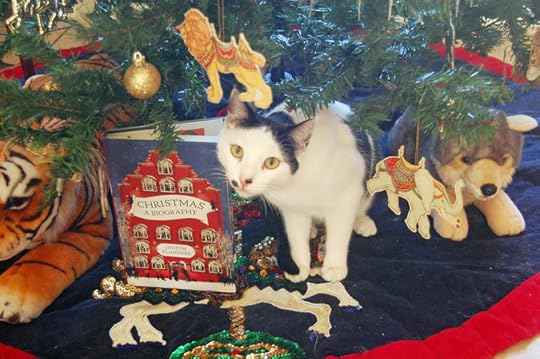 Ruby, Roary, and Argent Under the Tree
Ruby, Roary, and Argent Under the TreeThis week, because I’ve been going through audiobooks faster than usual, I did some jumping about in series. This can be a disaster with poor writers, forcing a reader to endure huge amounts of infodump. Both Bujold and Aaronvitch are skilled enough I have had no issues.
For those of you unfamiliar with this column, the Friday Fragments lists what I’ve read over the past week. Most of the time I don’t include details of either short fiction (unless part of a book-length collection) or magazines. The Fragments are not meant to be a recommendation list. If you’re interested in a not-at-all-inclusive recommendation list, you can look on my website under Neat Stuff.
Once again, this is not a book review column. It’s just a list with, maybe, a bit of description or a few opinions tossed in. And it’s also a great place to tell me what you’re reading. Two of the series I’m trying right now are due to FF reader mentions.
Completed:
Penric and the Shaman by Lois McMaster Bujold. Audiobook.
Penric’s Fox by Lois McMaster Bujold. Audiobook.
Mira’s Last Dance by Lois McMaster Bujold. Audiobook. I couldn’t get the audio for novella four, so I jumped. Good story, but I think I probably did need the prior for best effect. Still, this worked and I want to listen to the previous more than ever.
In Progress:
Written in Stone by Christopher Stevens. Non-fiction. I am now up to “T.”
The Liar’s Knot by M.A. Carrick. Sequel to The Mask of Mirrors. A few chapters in. Enjoying very much.
Whispers Underground by Ben Aaronovitch. Audiobook. This series has been mentioned repeatedly, and I really wanted to try it, but since I wanted audio, because I have room in that queue, I am starting with the third book. The author does a good job of supplying enough background while moving the plot ahead. Several cheers for doing a tough job well!
Also:
Dipping into Christmas: A Biography, which takes a look at how various things we assume have “always” been part of Christmas evolved.
December 22, 2021
And Roary Up in the Tree
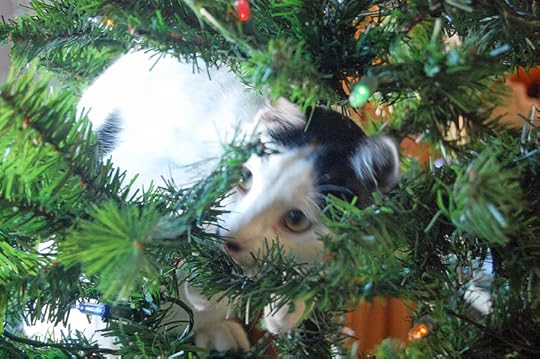 Stealth Roary
Stealth RoaryThe tree has stayed standing to this point, although Roary has been up in it repeatedly. Putting on ornaments definitely helped, since they were placed to block inviting openings.
Thus far, Persephone has been viewing the tree with the calm insouciance of a nearly ten-year-old cat who has seen it all. Shy girl Mei-Ling thinks that it’s terrific that we’ve decided to give her a new place to sit under and feel safe. She carries her treats onto the tree skirt to dine in secure comfort.
Since the tree is artificial, Dandy and Coco, the guinea pigs, have no opinion. They would prefer we made a tree out of kale with a celery stalk trunk, and ornaments cut from various vegetables. Carrot strips could serve as garland.
I made a lot of cookies this past week. I’m shooting for a total of ten: cookie press butter, butter and walnut balls, pecan/maple, sugar, gingerbread, hermits, fudge, meringues, sesame balls, and… I’m forgetting the last one…. Got it! Linzer tarts.
The sugar cookies and gingerbread will be decorated in stages. It’s more fun that way than doing a marathon. My collection of cookie cutters is wildly varied, so in addition to the more usual trees, wreathes, stars, bells, reindeer and the like, we have buffalo, bears, rhinoceros, stegosaurus, rocket ships, and, of course, wolves and coyotes. And cats and guinea pigs. Can’t forget the cats and guinea pigs.
It occurs to me that I make cookies the same way I write: a lot of variety, not one type of cookie, or theme or motif. Variety definitely fuels my creativity.
Now to go put jam between the layers of the Linzer tarts. Last year I used cactus pear, the year before, raspberry. This year will be cherry. All three red, all three different.
May these crazy days leading up to the Christmas weekend be filled with fun for you, whether you’re travelling or home, being a guest or having guests, or simply enjoying some peace and quiet!
December 17, 2021
FF: You’ll Notice That
 Roary Never Lies
Roary Never LiesYou’ll notice that my reading is up this week. This is because I use audiobooks as background when doing chores, and there have been a lot of chores in the last week.
For those of you unfamiliar with this column, the Friday Fragments lists what I’ve read over the past week. Most of the time I don’t include details of either short fiction (unless part of a book-length collection) or magazines. The Fragments are not meant to be a recommendation list. If you’re interested in a not-at-all-inclusive recommendation list, you can look on my website under Neat Stuff.
Once again, this is not a book review column. It’s just a list with, maybe, a bit of description or a few opinions tossed in. And it’s also a great place to tell me what you’re reading.
Completed:
Terciel & Elinor by Garth Nix. A prequel to Sabriel, featuring her parents. Good read, although suffering some from in jokes that only a reader of later books in the series would get.
Curtains For Three by Rex Stout. Audiobook.
Plot It Yourself by Rex Stout. Audiobook.
Penric’s Demon by Lois McMaster Bujold. Audiobook. This novella is set in the “World of the Five Gods” featured in The Curse of Chalion and Paladin of Souls. Very strong, with an engaging protagonist. First of the “Penric and Desdemona” series.
In Progress:
Written in Stone by Christopher Stevens. Non-fiction. I am now up to “N.”
Penric and the Shaman by Lois McMaster Bujold. Audiobook.
The Liar’s Knot by M.A. Carrick. Sequel to The Mask of Mirrors. Just started.
Also:
A scattering of magazine articles.
December 15, 2021
Wrapping Up
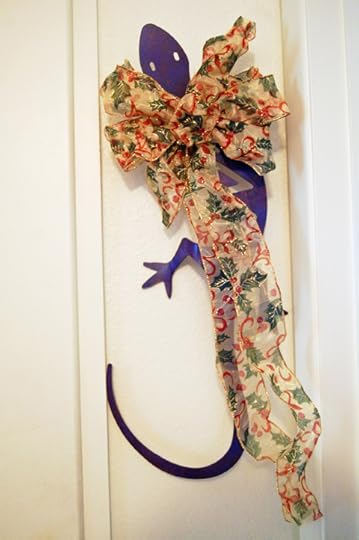 Lizard Dressed Up for the Holidays
Lizard Dressed Up for the HolidaysAt the end of last week, I turned in the page proofs for Aurora Borealis Bridge, the sequel to Library of the Sapphire Wind. They’ll be out early next year, in February and April.
With that job wrapped up, I took a look at the calendar and launched into all the neglected holiday preparations. Jim and I don’t live near to any of our families, so getting gift packages in the mail is the first thing. Next comes the Christmas letter. That’s my department. We do the cards together, usually to the accompaniment of appropriate music.
Jim’s been putting up decorations, a few at a time, which is nice, since it gives us a chance to savor them. We haven’t yet put up the tree, but when we do, it will go up with no decorations other than the lights (it’s a pre-lit sort), so that we can find out what the cats will think of it.
Last year, they pretty much ignored it, but we like to give them a chance to try and knock it over before adding decorations.
My first cat and my first “on my own” Christmas tree happened the same year, so most of our decorations are of the more or less unbreakable type. I say “more or less” because cats will always surprise you.
Breakable decorations are hung on a garland high up on the walls. It works.
We’ll also be starting the baking this week. We make a lot of cookies, some of which are fairly time-consuming, but it’s fun. Nothing on earth could make me do this if it wasn’t.
This year, my mom’s coming to stay with us for Christmas. Having a stranger in the house for more than a handful of hours will be a Major Event for Mei-Ling and Roary, neither of whom has ever had to deal with such, and both of whom tend to deal with guests by keeping their distance. I have no idea how they will cope. Stay tuned.
I have a few jobs to finish up, but after an incredibly intense year, where I pretty much went from job to job to job, I am trying to convince myself that a little downtime has been earned. Even so, I’ll be working, because a writer really never stops. There’s always creative thought going on.
I hope this finds all of you well… Now, maybe it’s time to put on some holiday music.
December 10, 2021
FF: Familiar, Unfamiliar, and Confusing
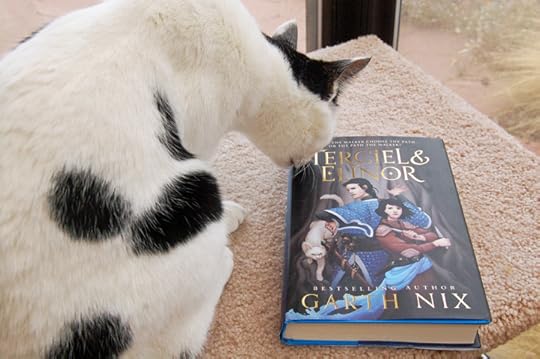 Roary Reads
Roary ReadsThis week I have quite a mix on my reading list… including one really popular book from this past year that I feel I must have missed something about.
For those of you unfamiliar with this column, the Friday Fragments lists what I’ve read over the past week. Most of the time I don’t include details of either short fiction (unless part of a book-length collection) or magazines. The Fragments are not meant to be a recommendation list. If you’re interested in a not-at-all-inclusive recommendation list, you can look on my website under Neat Stuff.
Once again, this is not a book review column. It’s just a list with, maybe, a bit of description or a few opinions tossed in. And it’s also a great place to tell me what you’re reading.
Completed:
And the Doorbell Rang by Rex Stout. Audiobook. One of my favorite of his endings. I laugh every time.
Death Times Three by Rex Stout. Audiobook.
Piranesi by Susanna Clarke. Not bad, but I must have missed something, because I really can’t see what the fuss was about. I’ve both read and written more complex surrealist fantasy. Feel free to tell me what I might have missed.
In Progress:
Written in Stone by Christopher Stevens. Non-fiction. Chatting anecdotal look at the origins of modern language. I wish this provided a little more about linguistic evolution, fewer pop culture references. I find myself reading it as I would free verse poetry, less like a source of information. Still, fun.
Terciel & Elinor by Garth Nix. A prequel to Sabriel, featuring her parents. I’m a little nervous about this, because it’s already established that they will die relatively young. However, I really like Garth Nix’s work in general and his “Old Kingdom” setting, in particular, so I want to give this a try.
Curtains For Three by Rex Stout. Audiobook.
Also:
Almost done reading the page proofs of Aurora Borealis Bridge, due out April 2022.
And read the most recent issue of Vogue.
December 8, 2021
It Never Gets Old
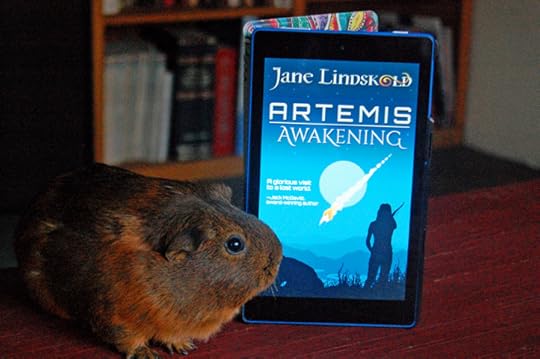 Coco Is Sure That’s a Crashing Spaceship
Coco Is Sure That’s a Crashing SpaceshipJust this last weekend, I received a copy of the first review of Library of the Sapphire Wind, my forthcoming February 2022 release. It’s from Publisher’s Weekly.
The review is a little spoilery, so out of respect for those who hate spoilers, I won’t quote it all here but I can’t resist quoting the final line: “This vivid, magical tale is sure to please.”
I’ve been a fulltime writer since mid-1994, with my first novel (Brother to Dragons, Companion to Owls) coming out December of that year. You’d think that finding out that a perfect stranger is enthusiastic about one of my books would get old, but it never does.
If you’re interested in learning more about the actual novels, Baen Books has eARC’s available. You can find Library of the Sapphire Wind here, and if you really want a jump on the series, Aurora Borealis Bridge, which won’t be out until April, can be found here.
Remember, ARCs (advanced review copies) are based on uncorrected proofs. In fact, my other job starting the middle of last week has been reviewing the proofs for Aurora Borealis Bridge. I’m not making any major changes, so while the prose may differ slightly, the story remains the same.
In promised new news (and explaining the picture accompanying this piece), last week I finally finished getting the last of my backlist series titles up in a new e-book edition. Artemis Invaded joins Artemis Awakening, both with new covers by Jane Noel, and extra content essays by me.
If you prefer print, I have hard cover copies of both Artemis Awakening and Artemis Invaded in my website bookstore.
Next title up for a new e-book edition will be my stand alone novel, Child of a Rainless Year, but this won’t be until sometime in the new year.
Right now, as I finish projects, I’m letting myself have a little downtime, but I’m not there yet! Time to go read more of those proofs!



